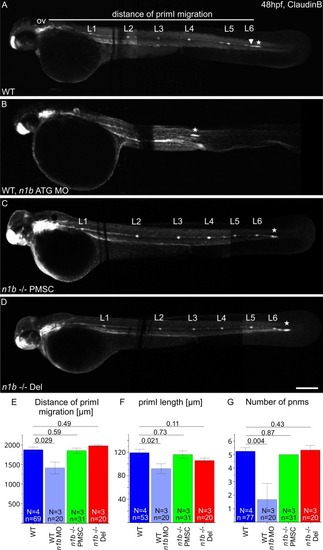Fig. 1
- ID
- ZDB-FIG-250903-61
- Publication
- Lange et al., 2025 - Genetic compensation highlights the importance of neural cell adhesion molecule Ncam1 paralogs in balancing signaling pathways during zebrafish lateral line development
- Other Figures
- All Figure Page
- Back to All Figure Page
|
ncam1b knockdown and knockout leads to different phenotypes in the development of the lateral line system. (A–D) Lateral views of 48 hpf Tg(ClaudinB::lynGFP) (A) Wild type (WT) (B) n1b morphant, (C) n1b -/- PMSC and (D) n1b -/- Del. Embryos are oriented with rostral to the left and dorsal to the top. (A) At 48 hpf, primI (star) of WT reaches the tip of the tail and deposits 6 proneuromasts (L1-L6), with the last one having just been deposited (arrow). The migration distance was measured from the otic vesicle (ov) to primI. (B) ncam1b morpholino injection leads to reduced migration of a smaller primI and deposition of fewer proneuromasts. (C + D) n1b -/- PMSC and n1b -/- Del mutants phenocopy the WT phenotype, with primI reaching the tip of the tail at 48 hpt and depositing 6 proneuromasts (L1-L6). (E–G) Quantification of migration distance, primI length and number of proneuromasts in WT, ncam1b morpholino injected embryos, n1b -/- PMSC and n1b -/- Del. Bars indicate mean values of the medians of each experiment, with error bars representing standard error. Statistic was made using two-sided t-test. Scale bar 200 µm. Abbreviations: WT: Wild type; n1b -/- PMSC: ncam1b -/- Premature Stop Codon mutant; n1b -/- Del: ncam1b deletion mutant; MO: Morpholino; primI: primordium; pnm: proneuromast; ov: otic vesicle. |

